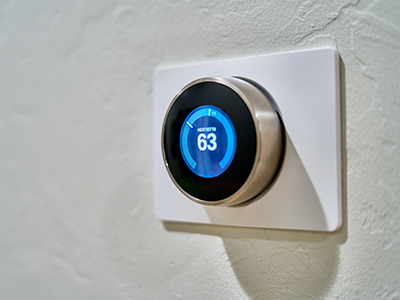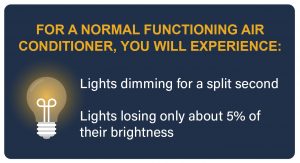How Does HVAC Cooling Work?

With summer in full swing, you might find yourself thinking about your residential air conditioner. Responsible for maintaining your ideal indoor temperature, HVAC systems are the unsung heroes of heating and cooling. Curious how these intricate machines do all the demanding work of cooling down your home? Our Portland HVAC installation and maintenance company has the answers.
How Does HVAC Equipment Work Together to Heat and Cool?
If you are completely new to HVAC systems, it’s a good idea to learn some fundamentals. Knowing a few key facts can help you troubleshoot any potential problems and ask more informed questions when talking with your HVAC contractor.
3 Basic HVAC Components You Should Know
To learn more about how residential heating and air conditioning work in tandem, let’s do a quick overview of the basic components of an HVAC system. Each unit is comprised of three essential parts.

1. A mechanism, or source, that heats or cools the indoor air, for example a furnace (heat source) and air conditioner (cool source).
2. A distribution element that helps circulate air throughout your home, like ductwork.
3. A temperature control unit, often a thermostat.
The sources, or mechanisms, in your residence use the same distribution means and temperature control to heat and cool your home. To put this into a real-life example, let’s say your home has a furnace for heating, central air conditioning to cool, and ductwork. In this case, even though your furnace and air conditioner play separate roles in your residential heating and air conditioning, both mechanisms will utilize the same ducts to force warmed or cooled air throughout your space. You will use the same thermostat to set your ideal indoor temperature in the winter and the summer.
How Do HVAC Cooling Systems Work?
How does an air conditioner remove warm air, where does the heat go, and how does this process effectively cool down your home? The answer to these questions depends on the type of cooling source in your residence.
The most common type of residential HVAC cooling is a central air conditioning split-system unit. Split-systems, like the name suggests, are composed of two separate units, located in two separate locations. The cooling unit is found outside, and the heating unit is housed inside. This type of air conditioner has three major components:
Compressor
The compressor is typically found in the outdoor part of the air conditioner unit. The compressor’s main job is to pump a cooling refrigerant, via a series of tubes, between the evaporator and the condenser.
Condenser
The condenser is the main exterior component that converts the refrigerant from gas to liquid. This allows the compressor to push the refrigerant to the evaporator coil.
Evaporator Coil
The evaporator coil is typically found inside the furnace. As the refrigerant moves through the coil, the evaporator coil draws in heat from the incoming air. From here, the cool air is distributed to rooms in your home via the duct system.
This process occurs over and over to achieve your ideal indoor temperature, which is based on your thermostat settings. In addition to cooling your home, air conditioning units can also help reduce humidity levels.
AAA Heating and Cooling, Local HVAC Contractors in Portland
If you are looking for more information on the best HVAC cooling options for your residential needs, AAA Heating and Cooling is here to help. Whether you are looking for an HVAC upgrade, AC repair, or to schedule routine maintenance, our expert contractors will get the job done! Contact us today to schedule an appointment.
3 Reasons Lights Flicker When Your Home’s AC is On
As a homeowner you may have noticed your lights flicker when you power up your air conditioning unit. What causes your lights to dim? Could it be a problem with the AC unit itself? Is there something wrong with the electricity in your home? Our Beaverton residential heating and air conditioning pros answer these questions and more.
Understanding Your Residential Air Conditioning Unit
Think of electricity in your home the same way you do your residential plumbing. Much like the water in your pipes, there is only so much electricity available in your home at any given time. When you flush your home toilet while running a shower, the water pressure splits between the two fixtures. Electricity behaves in a similar manner.
 When you turn on a high-energy device, like a modern AC unit, the initial power draw can put a substantial drain on your available electricity. This can cause your lights to dim. While flickering lights might seem worrisome, this is often a normal electrical response to power being diverted.
When you turn on a high-energy device, like a modern AC unit, the initial power draw can put a substantial drain on your available electricity. This can cause your lights to dim. While flickering lights might seem worrisome, this is often a normal electrical response to power being diverted.
How can you tell if the dimming lights are a normal occurrence or signs of a larger problem? For a normal functioning air conditioner, you will experience:
- Lights dimming for a split second
- Lights losing only about 5% of their brightness
Lights that dim for a long time, flicker on and off rapidly, or only dim on particular circuits could be symptomatic of more serious electrical issues. What are the more serious issues and when should you speak with a professional?
1. Damaged or Loose Wires
Do your lights turn off and on quickly when you start up your AC unit? This could be indicative of loose or damaged electrical wires. Faulty wires can cause current loss to your lightbulb. Plus, the voltage drop that occurs when your air conditioner kicks on can exacerbate the problem, making your lights flicker rapidly. Not sure if your wires need repair? Make an appointment with your Beaverton HVAC contractor to check if your wires are discolored, charred, or loose.
2. Weak or Broken Capacitor
 If your lights are losing 30% to 40% percent of their illumination when the AC starts, that’s a sign of a capacitor issue. Your AC capacitor functions like a battery, giving your compression motor the boost of energy it needs to power up. Much like your car battery, your air conditioning compressor can lose its ability to store and maintain power.
If your lights are losing 30% to 40% percent of their illumination when the AC starts, that’s a sign of a capacitor issue. Your AC capacitor functions like a battery, giving your compression motor the boost of energy it needs to power up. Much like your car battery, your air conditioning compressor can lose its ability to store and maintain power.
What does this mean? Your AC is pulling more voltage from other appliances and putting more stress on your compressor to start up. This can cause the lights to temporarily lose their brightness.
3. Overloaded Circuits
Overloaded circuits can present a serious problem. According to the National Electric Safety Code, all major appliances should be on their own dedicated circuit. If you trip your circuit breaker, or hear any buzzing sounds when you turn on your AC unit, you could be overloading your circuits. If you notice any of these signs, unplug any household devices that share the same circuit as your AC unit. This will reduce your risk of fires and electrical shock. For a long term solution, you will need to get a complete assessment and potential repair from your HVAC professionals.
Home HVAC Solutions in Beaverton & Portland
If you aren’t sure what might be causing your flickering lights, call in the experts. AAA Heating and Cooling is your go-to residential HVAC servicing and installation company. We now have two locations, in Portland and Beaverton!